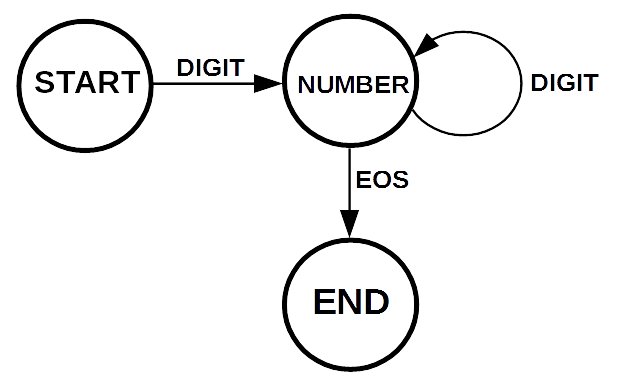
Parse a string and verify it is an integer. In the above diagram:
| DIGIT | - | the characters "0" thru "9" |
| EOS | - | end of string |
Note: The starting and ending spaces have been removed from the string.
Python Code - Parse an Integer
# ========================================================== # Test String to Integer Conversion # ---------------------------------------------------------- # This is not the most efficient code. I designed it as # a demonstration. It could be more efficient. # ========================================================== # ---------------------------------------------------------- # convert string to integer # ---------------------------------------------------------- def StringToInteger(str): # --- initialize local variables i = 0 # string character index l = len(str) # string length vp = True # value is positive v = 0 # string's integer value # --- test string length if l == 0: return False,0 # --- process string sign = False # found a [+-] character while i < l: c = str[i] # get a string character print('c={},v={},i={}'.format(c,v,i)) i = i + 1 # increment string index if c == "+": # character "+" if sign: # found more that one sign? return False,0 # error sign = True # found + sign elif c == "-": # character "-" if sign: # found more that one sign? return False,0 # error sign = True # found - sign vp = False # value is negative elif c == "0": # character "0" v = v*10 elif c == "1": # character "1" v = (v*10) + 1 elif c == "2": # character "2" v = (v*10) + 2 elif c == "3": # character "3" v = (v*10) + 3 elif c == "4": # character "4" v = (v*10) + 4 elif c == "5": # character "5" v = (v*10) + 5 elif c == "6": # character "6" v = (v*10) + 6 elif c == "7": # character "7" v = (v*10) + 7 elif c == "8": # character "8" v = (v*10) + 8 elif c == "9": # character "9" v = (v*10) + 9 else: # illegal character return False,0 if not vp: # negative value? v = -v return True,v # end of string # --------------------------------------------------------- # main (test code) # --------------------------------------------------------- if __name__ == '__main__': # --- python version function ------------------------- import sys def RunningPython3(): ##print(sys.version_info) if sys.version_info[0] == 3: return True return False # --- get use input function -------------------------- def GetUserInput(prompt,py3): if py3: return input(prompt) else: return raw_input(prompt) # --- pause the program function ---------------------- def Pause(py3): GetUserInput('\nPress enter to continue ',py3) # --- ask the user for input -------------------------- py3 = RunningPython3() while True: s = GetUserInput('\nEnter integer number: ',py3) s = s.strip() # remove leading/trailing spaces if s == '': # empty string? break r,v = StringToInteger(s) if r: print('Returned Value {} {}'.format(v,type(v))) else: print('Oops! an error (returned value={})'.format(v)) Pause(py3)